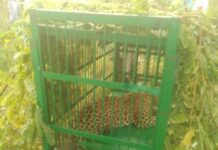KL NEWS NETWORK
SRINAGAR
The Union Home Ministry appointed expert committee has zeroed in potent and newly developed ‘PAVA shells’, a chilli-based less-lethal munition as an alternative to pellet guns.
PAVA shells temporarily incapacitates the target and renders them immobile for several minutes.
The Home Minister, who returned to New Delhi Thursday afternoon, had said that the committee will submit the report in a few days.
Reports said that the committee early this week held a full-fledged demonstration of the maiden shells at a test field in the Union capital and gave its thumbs up for use by the forces in “protest-like” situations in the Kashmir valley in place of the pellet guns.
Over 500 persons were hit and injured by the pellets in last 48 days during mass protests triggered by the death of popular militant commander Burhan Wani on July 08, 2016.
Over 50 persons, majorly teenaged, have lost their eye sight.
The ‘PAVA shells’ were under testing for over an year at the Indian Institute of Toxicology Research, a Council of Scientific and Industrial Research (CSIR) laboratory in Lucknow and its full development has come right on time when it was most needed.
Report said that the panel has favoured ‘PAVA shells’ as an alternative to pellet guns and has recommended that the Tear Smoke Unit (TSU) of the BSF in Gwalior should be tasked with the bulk production of the shells “immediately”, with the first lot not of less than 50,000 rounds.
The name ‘PAVA’ stands for Pelargonic Acid Vanillyl Amide, also called Nonivamide, and is an organic compound found characteristically in natural chilli pepper.
On the Scoville scale (the degree to measure the power of chilli), PAVA is categorised as “above peak” meaning it will severely irritate and paralyse humans, but in a temporary fashion. It is also used as a food additive to add pungency, flavouring and spicy effect to food.
The committee found that ‘PAVA’ can be categorised in the less-lethal munition category and once fired, the shells burst out to temporarily stun, immobilise and paralyse the target (protestors) in a more effective way than a tear gas shell or pepper sprays.
The panel noted that PAVA is “bio-safe, better than chilli grenade or tear smoke shell and can also be used in combination with stun and tear shells” by forces facing unruly protestors in place of pellet guns.
The committee also analysed and is understood to have recommended the supply of few other non-lethal/less-lethal munition to forces personnel deployed for crowd control and counter-protests in the Kashmir valley and other similar situations elsewhere.
These munitions include ‘dye marker grenade with irritant’ which not only causes sensory trouble to the target once fired but also leaves a dye mark on them for easy identification by security personnel.
Another alternative to pellet guns include ‘Tear Smoke Shell with Soft Nose’ which does not give serious injury to protestors when hit directly and its plastic body starts melting immediately on landing with emission of the smoke making it difficult to pick and throw away.
The committee sought to recommend this munition as they were briefed that protestors used to pick and throw the shells fired by security forces back.
A ‘stun grenade’, made by the TSU of the Border Security Force, which leads to temporary stunning of the target and makes a blinding flash for few minutes is another option studied and recommended by the committee, constituted last month.
The TSU was created in 1976 in Gwalior in Madhya Pradesh to equip the country in the production of indigenous riot control products.
As of now, it produces over 75 varieties of munitions including five new ones to be launched soon.















